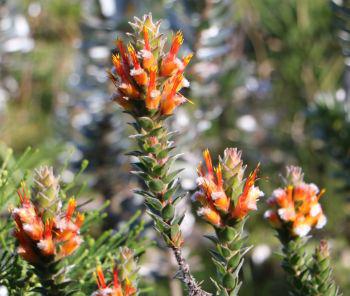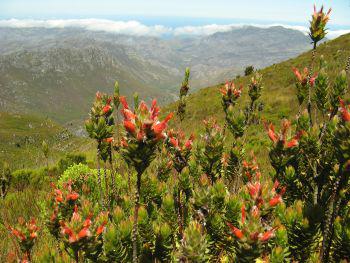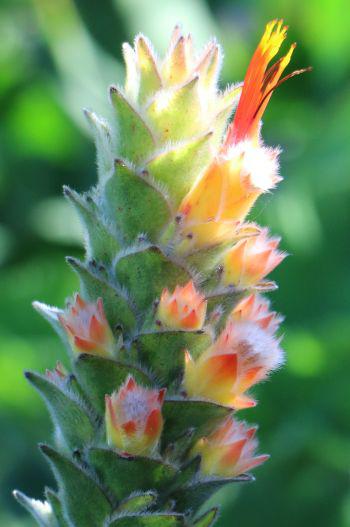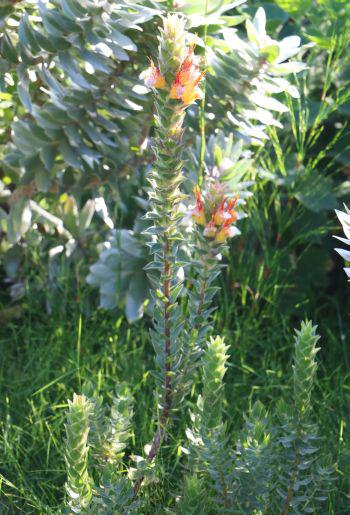Mimetes capitulatus
Mimetes capitulatus (L.) R.Br.
Family: Proteaceae
Common names: conical pagoda (Eng.); skraalstompie (Afr.)
Introduction
This striking plant is a lesser-known gem, whose brightly coloured, red and orange flowerheads, appear in spring time, attracting the sunbirds. Populations are scattered on top of the higher coastal mountains of the southwestern Western Cape. Unfortunately, it is a rare species with a fragmented distribution range, containing from as many as a few dozen, up to about 100 plants per population, with the exception of the populations on Groenlandberg, which may consist of up to 1 000 plants.

Description
Description
Mimetes capitulatus is an erect, rounded shrub, growing up to 2 m tall. The stems are short and laterally branching. Flowering stems are tall, however, unbranched with flowers presented on terminal spikes. The flowerhead is 60–100 mm long, and 60–80 mm wide and comprised of 10–13 headlets. The involucral bracts of the flower are 15–40 mm long, 3–14 mm wide and orange-red. The style is 30–35 mm long, red with a yellow tip and the pollen presenter is club-shaped, 2 mm long,. The headlet with its flowers are subtended by an inconspicuous grey leaf. Flowering occurs from June to December, but mainly in August. Oblong seeds are produced from November to February.

Conservation Status
Status
This species is Rare and is currently assessed as Endangered (EN) according to the Red List of South African plants, as it is a fire-dependent population, occurring at only 5 known locations, where the habitat quality and the number of mature individuals continues to decline as a result of wildflower harvesting. Unfortunately, some observed population declines are not understood, but are thought to be due to inappropriate fire management or could possibly be drought related.

Distribution and habitat
Distribution description
This species occurs at altitudes of 600–1 200 m above sea level, on the swampy southern slopes of mountain peaks, which are either immediately or nearly adjacent to the sea. It occurs as isolated clumps of plants in the Kogelberg, Groenland and Klein River Mountains and is largely confined to Kogelberg sandstone fynbos, where it grows in acid soil containing a fair amount of humus; it requires permanently moist even swampy growing conditions.
The area it occurs in experiences a winter rainfall, receiving about 1 500 mm a year, but the rainfall is supplemented in summer by moisture-laden clouds which blanket the upper slopes.
It grows amongst companion plants, such as Berzelia ecklonii and B. alopecuroides and Elegia mucronatum.

Derivation of name and historical aspects
History
Mimetes capitulatus, was discovered by Dr William Roxburgh between 1798 and 1799, but unfortunately no precise locality was given. In 1801, Robert Brown, who was a revered and respected figure and dominated the British botanical scene during the nineteenth century, accompanied Mathew Flinders in H.M.S. Investigator on a voyage to Australia. En route, they stopped at the Cape during October of that year. In Simonstown, Brown encountered Proteaceae, including Mimetes, and made it the subject of an intense study in 1810. Brown's experience was confined to the species from the Cape Peninsula, but collections made by James Niven and Dr William Roxburgh from further afield, formed the basis of his study. Brown acknowledged Dr Roxburgh before the Linnean Society of London, for the assistance he had received from the extensive collection presented to the society by Dr Roxburgh, in which Dr Roxburgh had included many observations of this particular group of plants, such as sexes, localities and size.
R.A. Salisbury established the genus Mimetes in 1807, after subdividing the genus Leucadendron. The genus name was derived from the Greek word mimetes, meaning ‘to mimic or imitate’. The reference though is unclear, as there is no indication as to what the plant is supposed to be mimicking, since the genus itself is unique. The species name capitulatus, is derived from capitulum which is Latin, and means ‘a little head’ and is not immediately obvious, but according to John Rourke it may have been intended as a comparison with the larger flower heads of a related species, such as Mimetes hirtus.
Mimetes capitulatus is one of thirteen species in the genus, all of which are endemic to the Cape Floral Region. M. capitulatus is grouped with the tube pagodas, which also include M. hirtus, M. pauciflorus and M. palustris.
Ecology
Ecology
Members of the genus Mimetes have flowerheads adapted to pollination by birds. The brightly coloured, red and yellow bracts, attract birds, and the flowers provide the birds with large quantities of nectar. Sunbirds, particularly the Orangebreasted Sunbird (Nectarinia violacea) the Malachite Sunbird (Nectarinia famosa) and Lesser Double-collared Sunbird (Nectarinia chalybea) are the main pollinators visiting Mimetes species when in flower. M. hirtus and M. hottentoticus are also pollinated by the Cape Sugarbird (Promerops cafer).
Seeds of Mimetes ripen one by one, and only 2–6 months after pollination of each productive flower, does seed set. It can be held within the involucre, which is a whorl of bracts surrounding the inflorescence, until the floral parts drop off. Often at times though, the seed tends to fall to the ground earlier, due to either being dislodged by ants who are attracted to the elaiosomes of the young fruit, or by the wind.

Ants play a very important role in the distribution, as well as the underground storage of the seed. Underground, the seeds are safe from being eaten by rodents and can germinate after a fire. Seed dispersal by ants, is an ecologically significant ant-plant interaction, and is known as myrmecochory.
Plants at the age between 5 and 10 years, form rounded shrubs and at this stage, they flower profusely. As the plants age, the rounded bushy form remains, but several erect, undivided and lanky branches reaching a height of 1.5–2.0 m form. These branches continue to bear inflorescences, whereas the lower bushy growth produces very few flowerheads. This mode of growth is an indication of the onset of senescence, and flowering will continue to diminish. Mimetes capitulatus depends on periodic cyclical burns to rejuvenate the senescent populations.
Uses
Use
In 1978, grafted plants from 3 rare protea species, were released by the Cape Department of Nature and Environmental Conservation. One of these rare plants was Mimetes capitulatus, while the other species were Orothamnus zeyheri and Mimetes hottentoticus. Growers who were familiar with grafting techniques, were the first to receive plants and had to take on the responsibility to grow them as the success they achieved determined whether these plants could later become garden plants. Today, ex situ conservation is the main purpose for growing this species by conservationists and plant enthusiasts.

Growing Mimetes capitulatus
Grow
When planting out into the garden, plant Mimetes capitulatus in autumn or winter, in sandy soil, in an area that receives full sun. In the first year after planting, the plants need to become well established. During this period, the young plants are in a fragile state and need regular watering to prevent them from drying out. Pests to watch out for are sap-sucking insects, such as mealy bug and diseases, and root-attacking fungi such as Phytophtora.
Propagating Mimetes from seed sown in autumn is satisfactory, but despite the great number of flowers, seed production is poor and for all members of the genus, only 0–2 seeds per capitulum form. In the case of M. capitulatus, it produces on average of 2 seeds per floret from 10–13 headlets per inflorescence. Seed, however, ripens one by one, with those flower buds facing the sun, developing and producing seed first. Seed can take from 2 to 6 months to set after pollination. Therefore, production via seed is difficult, due to their lack of availability.
Mimetes capitulatus can be propagated from cuttings made in February/March, using the new shoots which have emerged after flowering, from the flowering stems and hardened off before new flower buds have formed for winter/spring flowers. Cuttings are treated with a rooting hormone before placing the cutting into a rooting medium of 20% perlite, 30% coir and 50% bark. The cutting tray is placed onto bottom heating of 21–24°C, with overhead misting, which cools down the climate within the glasshouse and around the cuttings, and forms a thin film of water on the leaves of the plants, slowing down evaporation. The medium must be kept damp, but is not to be overwatered or allowed to dry out.
Once rooting begins, remove the rooted cuttings from the glasshouse to the hardening-off unit. It can take up to 4 weeks before rooting begins. Keep the cuttings in the hardening-off unit under 30% shade netting, for a period of 2 weeks, and then pot them up into a potting medium of 30% sand, 30% bark and 40% coir. Once potted, begin feeding with a liquid fertilizer, such as a fish emulsion.
Although cuttings may root, it has been found that plants are vulnerable to pathogens at lower altitudes, as the growing conditions for M.capitulatus are very specific. For this reason, growers prefer grafting cuttings of M. capitulatus onto suitable rooted rootstocks, such as Leucospermum ‘Veldfire’.

The rind graft is a good grafting technique to use, as the thin stems of the scion tend to be thinner than those of the rootstock onto which they are being grafted. Scion material is taken after flowering has finished, from suitable new growth in November. If grafting is done earlier in the year, the newly grafted plant will produce unwanted flowers, and not shoots.
Once the new shoots have hardened off enough, by showing some resistance when attempting to bend the cutting, the material can be taken for grafting. Cutting material needs to be straight and around 8–10 cm long, but can be shorter. Remove the lower half of the leaves on the scion and place the cuttings in water.
To make a rind graft, choose a healthy, single-stemmed, rooted plant as your rootstock. Cut the stem back and remove the leaves except for two. Position your grafting knife on the rootstock with the blade facing downwards and place the sharp edge along the bark. Gently push the blade all the way into the wood and carefully twist the blade left and right, lifting the cambium on either side, while trying not to break these flaps off.
Prepare the scion by making a wedge-type cut (a long flat cut) on the one side of the cutting, and a small ledge cut on the back side, to make it easier to insert the cutting under the cambium of the rootstock. Insert the scion and wrap grafting tape around the freshly made graft and seal the wound off completely. This procedure needs to be carried out within the least amount of time, and cuttings are to be kept in water so as to avoid moisture loss and to prevent oxidation by the exposure of the cells of the cutting, to air.
Place the grafted plants into a mist unit. Do not overwater, as this will cause disease and rot to set in. It can take up to 8 weeks for the graft to take. Leave the grafted plants in the mist unit until a shoot develops on the scion. Once a shoot develops, remove the grafted plant from the mist unit and harden it off under a 30% shade net. Remove any adventitious shoots that form on the rootstock.

References
- Collins, B.G. 1982. Pollination of Mimetes hirtus (Proteaceae) by Cape Sugarbirds and Orange-Breasted Sunbirds. Journal of South African Botany 49: 125–142.
- Brown, N.A.C. & Duncan, G.D. 2006. Grow fynbos plants. Kirstenbosch Gardening Series. South African National Biodiversity Institute, Cape Town.
- Germishuizen, G. & Meyer, N.L. (eds) 2003. Plants of southern Africa: an annotated checklist. Strelitzia 14. National Botanical Institute, Pretoria.
- Goldblatt, P. & Manning, J. 2000. Cape Plants. A conspectus of the Cape flora of South Africa. Strelitzia 9. National Botanical Institute, Pretoria & Missouri Botanical Garden, Missouri.
- Hull, E. 2016. Conversation. Propagating Mimetes capitulatus by cuttings, 23 August.
- iSpot southern Africa http://www.ispotnature.org/species-dictionaries/sanbi/Mimetes%20capitulatus?nav=search
- Paterson-Jones, C. 2000. The protea family in southern Africa. Struik Publishers, Cape Town
- Paterson-Jones, J.C. 1978. ‘Mimetes’. Veld & Flora 64(3): 78–80
- Rebelo, T. 1995. Proteas, a field guide to the proteas of southern Africa . Fernwood Press, Cape Town.
- Rebelo, A.G. et al. 2006. Mimetes capitulatus (L.) R.Br. Red list of South African plants. http://redlist.sanbi.org/species.php?species=804-3. 29/08/2016.
- Rourke, J.P. & Lincoln, T. 1982. Mimetes: an illustrated account of Mimetes Salisbury and Orothamnus Pappe, two notable Cape genera of the Proteaceae. Tiyan Publishers, Cape Town .
- Rourke, J.P. 1984. A revision of the genus Mimetes. Journal of South African Botany Volume 50.
- Thomas, R. 2016. Conversation. Grafting Mimetes capitulatus, 9 August.
- Van der Zeyde, A. 1984. Sukses met Mimetes hirtus (L.) Salisb. ex Knight, op Bettysbaai. Veld & Flora 70: 71.
- Vogts, M. 1982. South African's Proteaceae: know them and grow them. Struik, Cape Town.
Credits
Karen Wall
Harold Porter National Botanical Garden
September 2016
Plant Attributes:
Plant Type: Shrub
SA Distribution: Western Cape
Soil type: Sandy
Flowering season: Spring, Winter
PH: Acid
Flower colour: Red, White, Yellow, Orange
Aspect: Full Sun
Gardening skill: Challenging
Special Features:
Horticultural zones







Rate this article
Article well written and informative
Rate this plant
Is this an interesting plant?
Login to add your Comment
Back to topNot registered yet? Click here to register.